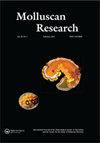Predation on the egg of Coelostoma stultum (Coleoptera: Hydrophilidae) by the alien species Deroceras laeve (Mollusca: Gastropoda: Agriolimacidae)
IF 0.6
4区 生物学
Q3 ZOOLOGY
引用次数: 3
Abstract
ABSTRACT Slugs are polyphagous herbivores that damage various crops. The genus Deroceras is primarily herbivorous; however, certain species are known to feed on various types of organic matter. In this study, we documented field observations of predation by Deroceras on eggs of the water scavenger beetle Coelostoma stultum at the waterside of paddy fields in central Japan and identified the predator species by DNA barcoding. Molecular phylogenetic analyses revealed that the slugs found sympatrically with C. stultum are Deroceras laeve, whose two haplotypes are widely distributed throughout the Palearctic and eastern margin of Asia. In two of three observed predation events, D. laeve thrust its head into the egg cocoon and preyed on eggs while C. stultum females were spinning. In the other event, no females spinning egg cocoons were observed. Due to the relatively large body size of the slug, it may push the female beetle away and prey on eggs. Considering the native distribution range of these two species, invasion of D. laeve has resulted in a new combination of predator–prey relationships in Japan between D. laeve and native C. stultum. It is a matter of concern that slugs may establish predatory pressures that threaten C. stultum.外来物种Deroceras laeve(软体动物:腹足目:Agriolimachidae
蛞蝓是一种多食性食草动物,会破坏各种作物。Deroceras属主要是草食性的;然而,已知某些物种以各种类型的有机物为食。在这项研究中,我们记录了在日本中部稻田水边,Deroceras捕食食水甲虫Coelostoma stultum卵的实地观察结果,并通过DNA条形码识别了捕食者物种。分子系统发育分析表明,与C.stultum共病发现的蛞蝓是Deroceras laeve,其两个单倍型广泛分布在整个北北极和亚洲东部边缘。在三次观察到的捕食事件中,有两次是D.laeve把头伸进卵茧中捕食,而C.stultum雌性则在旋转。在另一个事件中,没有观察到雌性旋转蚕茧。由于蛞蝓的体型相对较大,它可能会将雌性甲虫推开并捕食卵。考虑到这两个物种的本地分布范围,D.laeve的入侵在日本导致了D.laeve和本地C.stultum之间捕食者-猎物关系的新组合。令人担忧的是,蛞蝓可能会形成掠夺性压力,威胁到C.stultum。
本文章由计算机程序翻译,如有差异,请以英文原文为准。
求助全文
约1分钟内获得全文
求助全文
来源期刊

Molluscan Research
生物-动物学
CiteScore
1.80
自引率
10.00%
发文量
27
审稿时长
>12 weeks
期刊介绍:
Molluscan Research is an international journal for the publication of authoritative papers and review articles on all aspects of molluscan research, including biology, systematics, morphology, physiology, ecology, conservation, biogeography, genetics, molecular biology and palaeontology.
While the scope of the journal is worldwide, there is emphasis on studies relating to Australasia and the Indo-west Pacific, including East and South East Asia. The journal’s scope includes revisionary papers, monographs, reviews, theoretical papers and briefer communications. Monographic studies of up to 73 printed pages may also be considered.
The journal has been published since 1957 (as the Journal of the Malacological Society of Australia until 1993). It is free to members of the Malacological Society of Australasia and the Society for the Study of Molluscan Diversity.
 求助内容:
求助内容: 应助结果提醒方式:
应助结果提醒方式:


